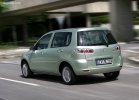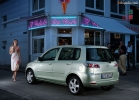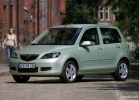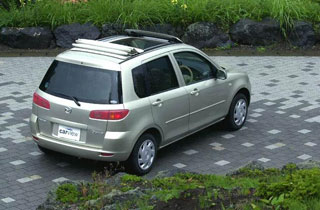Test drive Mazda Mazda 2 (Demio) 2002 hatchback
Citizen
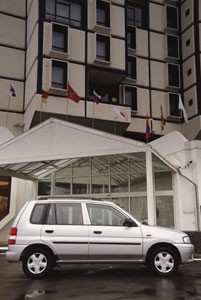 The Mazda Demio model debuted in Europe at the end of last year, in Japan it has been sold since 1996. The car body can be called a hatchback, and a small UPV, and a compact mini-van, i.e. Micro -wen - as you like.
The Mazda Demio model debuted in Europe at the end of last year, in Japan it has been sold since 1996. The car body can be called a hatchback, and a small UPV, and a compact mini-van, i.e. Micro -wen - as you like. Compact cars in Japan are in high demand, and Mazda Demio is confidently among the favorites. Last year, the most popular model - the thirtieth (!) Year in a row - turned out to be Toyota Corolla (sold 187.771 copies). In second place - Nissan Cube (107.857 copies), and on the third - Mazda Demio (102.377 copies), the best -selling model of the company.
Similar - small, but spacious - cars are gaining popularity in Europe. The amazing success of the Renault Megane Scenic does not count - this is a larger car and a higher class. But the direct classmates of Demio - Volkswagen Polo, Suzuki Wagon R+, Daihatsu Gran Move and the similar ones (if not for this group could also attribute Mercedes A -class) are also well sold. A whole market niche appeared, and Mazda hopes that there is enough space for Demio ...
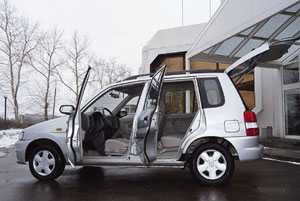 No matter how beaten the expression from the inside more than outside, when describing Demio, you have to use it. The car seems small, no more than Daewoo Tico (in fact, demio is half a meter longer), but it is worth sinking in the seat, how do you begin to be perplexed: where is there so much space from? The knees do not rest against the steering wheel switches, the hands bent in the elbows are comfortable on the steering wheel, switching gear or taking a handbrake, do not think about the passenger sitting next to him. Even above the head - despite the vertical landing of the driver - ten centimeters remains.
No matter how beaten the expression from the inside more than outside, when describing Demio, you have to use it. The car seems small, no more than Daewoo Tico (in fact, demio is half a meter longer), but it is worth sinking in the seat, how do you begin to be perplexed: where is there so much space from? The knees do not rest against the steering wheel switches, the hands bent in the elbows are comfortable on the steering wheel, switching gear or taking a handbrake, do not think about the passenger sitting next to him. Even above the head - despite the vertical landing of the driver - ten centimeters remains. After inspection of the machine, it becomes clear what methods the struggle for volume was carried out. Firstly, the flat floor of the body is noticeably lowered (the clearance of the car, set by the lower point of the power unit, is also withstanding the bottom of the bottom). Secondly, the doors and side panels of the body are extremely thin and almost vertical (this increased the living space and made it possible to achieve almost the same width of the salon at the floor level and under the ceiling). Thirdly, - the thin backs of the seats, which also set the more vertical landing (the distance for the legs of the rear passengers is won and, in addition, in the folded state of the back occupy less space).
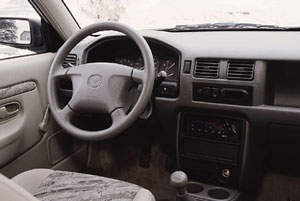 The steering column does not have adjustments, but you can get behind the steering wheel easily - changing the height of the driver's seat pillow. A harsh seat with a backless back seemed to be too comfortable. (Looking ahead, let's say that, having traveled, you get used to it. But the lateral support is not needed here, Demio is not for high -speed turns.) But what kind of circular review is opened from it! The large area of \u200b\u200bglazing and the eye from a height allow you to perfectly feel the dimensions of the car and confidently park in tight places without risk to hook something. Vertical windows in the rear racks are useful. It is visible through them not very much, but they help to navigate.
The steering column does not have adjustments, but you can get behind the steering wheel easily - changing the height of the driver's seat pillow. A harsh seat with a backless back seemed to be too comfortable. (Looking ahead, let's say that, having traveled, you get used to it. But the lateral support is not needed here, Demio is not for high -speed turns.) But what kind of circular review is opened from it! The large area of \u200b\u200bglazing and the eye from a height allow you to perfectly feel the dimensions of the car and confidently park in tight places without risk to hook something. Vertical windows in the rear racks are useful. It is visible through them not very much, but they help to navigate. From the rear seats, the review is even better - the total sofa is raised relative to the front seats by 60 mm, however, due to the spaciousness above the heads of passengers. The sofa shifts 60 mm forward, increasing the volume of and so quite an impressive luggage compartment (679 liters with folded backs), however, only small passengers can arrange for next.
The slope of the separate backs of the sofa is regulated: forward - until the seat is completely touching, back to the horizontal position, so that sitting from the back they have the opportunity to lie down. And having back the backs of the front seats, you can build - if you suddenly need a whole double bed. (The cargo compartment due to the wheel arches protruding orally than the passenger, therefore, before completely leaning back, you will have to unfasten the outer sidewall.)
The side doors open widely - in open state, they are fixed almost perpendicular to the body, which in combination with the seats close to thresholds facilitates landing and landing. But the back door is designed unsuccessfully. In order to open it, you have to simultaneously press the button and raise the door - either unthinkably spreading your fingers to reach the stamping, or with the other hand. The door does not rise very high, hangs over the opening, so in order to approach the car closely, you will have to lean.
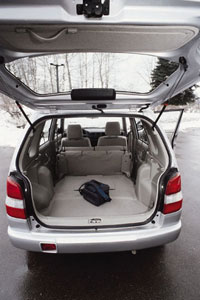 Even one glance inside the cargo compartment (with a folded rear seat) is enough to forgive everything. The formed platform is absolutely even, impressive in area and has a low loading height. Safety belts fixed on the floor can be hidden in special niches - so that they do not interfere with the placement of pods or not scratch it.
Even one glance inside the cargo compartment (with a folded rear seat) is enough to forgive everything. The formed platform is absolutely even, impressive in area and has a low loading height. Safety belts fixed on the floor can be hidden in special niches - so that they do not interfere with the placement of pods or not scratch it. To hide from prying eyes the contents of the trunk are called upon a storm -lamp twisting into a roll, made of dense plastic - if necessary, you can put light objects on it. When loading the car is higher than to waist, the curtain will have to be removed from the latches.
The cladding of the torpedo and interior elements is made of solid in appearance, but cold and hard gray plastic. The design of the salon is more functionally than stylishly - a typical inexpensive Japanese car. The dashboard is not overloaded - four easily readable scales with good backlight. All control of wipers and washers (front and rear) is unusual - in Japanese - concentrated on one steering wheel lever. And I had to use all this constantly - the road was wet.
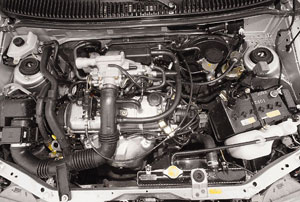 DEMIO is exported with 1.3 liters of a 16-valve engine with a capacity of 72 hp. (For some markets - 63 hp more powerful 1.5 l of the 99 -horsepower engine, the Japanese left for domestic consumption). The engine is quite dynamic and painful, up to a hundred, the machine accelerates in less than 14 seconds - a perfectly acceptable indicator.
DEMIO is exported with 1.3 liters of a 16-valve engine with a capacity of 72 hp. (For some markets - 63 hp more powerful 1.5 l of the 99 -horsepower engine, the Japanese left for domestic consumption). The engine is quite dynamic and painful, up to a hundred, the machine accelerates in less than 14 seconds - a perfectly acceptable indicator. There are no complaints about the steering, but it does not cause admiration - the assessment is normal. The pedals are highly located - on long trips, the driver will get tired. Switching transmissions - without problems, but if you hold your hand on the lever, it is noticeable how it is pressed for a decent gas pedal forward - obviously along with the power unit. This is probably due to the too elastic attachment of the engine to the body. Maybe this is good for extinguishing vibration, but why then do not apply a cable drive to control the box?
The roll in the turns is minimal, the suspension is quite rigid and elastic - it is obvious that it has a certain potential for cargo transportation.
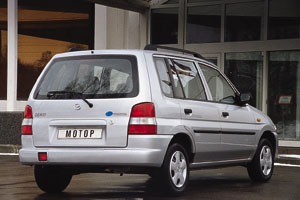 At high speed, not only the engine is clearly heard, but also the noise of the air dissected by the car - the high landing of Demio and the contrast of the contours do not improve aerodynamics. But in the city the car is transforming - it is at home. Closed transfer numbers of transmission easily allow you to keep the motor at the peak of power, and the 1000 -kilogram machine confidently feels confident in the conditions of the city stream - with sharp accelerations, overtaking and restructuring.
At high speed, not only the engine is clearly heard, but also the noise of the air dissected by the car - the high landing of Demio and the contrast of the contours do not improve aerodynamics. But in the city the car is transforming - it is at home. Closed transfer numbers of transmission easily allow you to keep the motor at the peak of power, and the 1000 -kilogram machine confidently feels confident in the conditions of the city stream - with sharp accelerations, overtaking and restructuring. There were four passengers in the cabin - we loaded the car for about 300 kg. The car lost a little in dynamics, but remained still easy and obedient to control. On brake qualities, the additional weight did not affect in any way, at least subjectively.
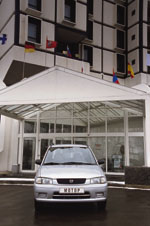 In the city modes of movement in the car quietly, nothing creaks, does not buzz and does not rattle. The engine is listened only to after 3500 rpm. It is best heard how small pebbles and sand raised by wheels are knocked on the arches and bottom. It seems that below the car is not covered with anything. Obviously, the Japanese, hoping for a galvanized body, did not take care of the additional measures of its protection.
In the city modes of movement in the car quietly, nothing creaks, does not buzz and does not rattle. The engine is listened only to after 3500 rpm. It is best heard how small pebbles and sand raised by wheels are knocked on the arches and bottom. It seems that below the car is not covered with anything. Obviously, the Japanese, hoping for a galvanized body, did not take care of the additional measures of its protection. For some reason, Mazda cars always fell into our hands in the winter. This time it was at the end of March, but in the yards there were enough ice bumps and melting loose snow. Despite the typically urban purpose, Demio has a rather large (160 mm) road clearance, which, combined with short overhangs, allowed the car to successfully overcome deep ice ruts. True, in the snow - on summer tires - the car was stuck, but it did not lie on the belly, and independently, gear, got out on a solid coating ...
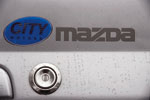 Promoting Demio in the UK, Mazda promised for each sold car to plant five trees - to compensate for the damage caused by the environment. Even bushes are not offered to plant. Yes, and it is unlikely that such a gesture would have attracted customers, another thing is more important to them - the seductive price of the car. It determines the disadvantages of Demio - a modest interior design and not very bright speed qualities. Among the obvious advantages are a spacious salon, a voluminous luggage compartment, excellent visibility and high economy. What else does an inexpensive city car need?
Promoting Demio in the UK, Mazda promised for each sold car to plant five trees - to compensate for the damage caused by the environment. Even bushes are not offered to plant. Yes, and it is unlikely that such a gesture would have attracted customers, another thing is more important to them - the seductive price of the car. It determines the disadvantages of Demio - a modest interior design and not very bright speed qualities. Among the obvious advantages are a spacious salon, a voluminous luggage compartment, excellent visibility and high economy. What else does an inexpensive city car need? Evgeny Romantovsky
Source: Motor magazine [No. 4/1999]
Video Crash tests Mazda Mazda 2 (Demio) 2002
Mazda Mazda 2 (Demio) 2002 test drives
Mazda Mazda 2 (Demio) 2002 Krash Test
Krassh Test: Detailed Information26%
Driver and passengers
10%
Pedestrians
25%
Children-passengers

